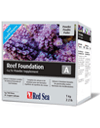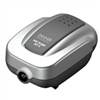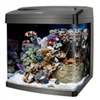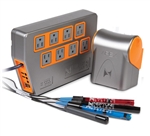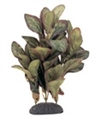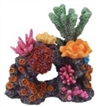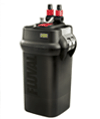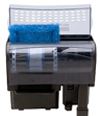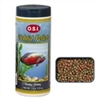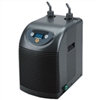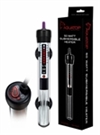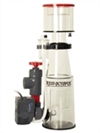Do You Need An Aquarium Chiller?Maintaining an optimal tank temperature in the summer months can be a challenge. Marine tanks need to be at 82 degrees or under, and often houses are close to that temperature. The heat generated by aquarium equipment can push a tank in a 78-degree house to a temperature over 82 degrees.
An aquarium chiller (
also referred to as an aquarium cooler, aquarium water chiller, saltwater chiller, fish tank chiller & tank chiller) is often the only way to get your aquarium temperature down to a level safe for your aquarium inhabitants. Although aquarium chillers can be quite expensive,
MarineAndReef.com finds that aquarium chillers are quite economical for a couple of reasons:
1. Running an aquarium chiller will be cheaper than running your air conditioning when you're not home or on vacation. This is especially true for situations where no one is home during the day and the air conditioning is being kept on just for the sake of the aquarium. Chillers are not cheap, but neither are air conditioners or the electricity to run them.
2. Aquarium chillers are low-maintenance and high-longevity products. They usually last ten years when run year around. If you only run a chiller in the hot months, they can last a lot longer.
3. What if your air conditioner is not functioning? What is your plan B? How long will it take the HVAC company to fix the problem? What if you're on vacation? Without a chiller everything in your aquarium might die. What are the emotional and monetary costs of everything in your aquarium dying?
What Is the Optimal Aquarium Chiller Size? The
Teco &
JBJ Arctica aquarium water chillers we carry each have a recommended tank size (
provided by the manufacturer). Determining the correct size chiller takes many factors into account—including the amount of water in the tank and sump, the ambient air temp, the temp of the tank, and the heat put out by the lighting and the pumps. We highly recommend that you get an aquarium chiller that is more powerful than recommended. This is because as you go from the less powerful to more powerful aquarium chillers, the price does not increase much while the capability increases greatly. The larger the chiller for any given system, the longer it will last because the less it will run.
Where Is The Chiller Going To Go?
Chillers work just like air conditioners and refrigerators. They have water pass over a coil containing a refrigerant, such as Freon or Puron, which draws the heat away from the water and into the refrigerant. Then they cool the refrigerant coils by venting the heat out.
Because of the need to vent out hot air away from a chiller, the most common installation is to set a chiller next to the aquarium where the heat is removed from the aquarium and then exhausted into the room. All of the chillers we sell can be installed this way. However, this does have some disadvantages:
1. Your air conditioner will work harder since the air inside your home is being warmed up by the chiller.
2. The chiller is exposed and looks very unsightly.
3. The chiller controls are exposed so they can be bumped or tampered with by children.
Teco Chillers are specifically designed to be placed inside an aquarium stand. The Teco chillers do this by having a special vent that allows you to cut a hole in the back or side of your aquarium stand to vent the heat out of the stand. While this still heats the room, it keeps the chiller hidden from view and protects the chiller controls from being tampered with.
JBJ Arctica Chillers are not designed to be put in stands. We know many people do put them in stands, and they will work if put into a stand. But they will not work at maximum efficiency because the chiller will be recycling the hot air it produces.
The
JBJ Commercial Chillers (1/2 HP & larger at the bottom of the page) can be placed outside your house where all of the heat they draw from the tank goes straight outside. This solves all of the problems with having a chiller next to your aquarium, but it can be difficult to install since it involves cutting through walls to run plumbing.
What Is the Optimal Temperature?Corals come from a variety of ocean environments where the temperature ranges from the low seventies to the low nineties. Ideally, you should stick to corals from a single environment and maintain your tank at the normal temperature for that environment. However, since most reef aquariums have a variety of corals from different marine environments, sticking to the 75-82 degree range is a somewhat safe choice.
Tanks with cold water animals will require a chiller (
unless you keep your home really cold). Many cold water animals, both marine and freshwater, need an aquarium temperature between 60 and 70 degrees.
Chillers For Smaller Tanks?Nano reef tanks, such as the Coralife BioCube, JBJ Nano Cube & Red Sea Max, are creating a new need for small aquarium chillers (
aka nano chillers and aquarium micro chillers). We carry a number of
1/15 & 1/10HP chillers for smaller tanks. We also have the
Nova Tec IceProbe Chiller for tanks below 40 gallons that do not need a huge temperature drop.
Alternatives To Aquarium ChillersAir movement and ventilation can significantly reduce the temperature of a tank. Blowing air across the water surface, across the lights, or blowing air out through a vent in the hood or canopy can be easily done with a canopy fan. In situations where your aquarium is 30 gallons or less, a fan such as the
JBJ C-Breeze can bring down the temperature a couple of degrees.
Other tank cooling methods:
-Use LED lights.
-Cutting back lighting hours in the summer will help. However, with LED lights it won't be a huge difference.
-DC pumps run cooler than AC pumps.
-Remove the aquarium lid.
However, while these methods might do the trick if the room is 78 degrees and the tank is 80 degrees, it will not suffice if the room is 80 degrees and the tank is 85 degrees.
How Do Chillers Work?An aquarium chiller operates on the same principles as a refrigerator or air conditioner. Refrigeration gas, such as Freon, is compressed and run through a condenser. The condenser is a heat exchanger which removes heat from the hot compressed gas and allows it to condense into a liquid. The liquid refrigerant is then sent through an expansion valve, or capillary tube, where the pressure drops--which lowers the boiling point and makes it easy to evaporate. The refrigerant then goes through an evaporator where it can absorb heat. Tank water is pumped into a chamber around the evaporator allowing heat from the water to be transferred to the refrigerant. The loop is completed when the refrigerant goes into the compressor and back through the condenser where the heat is then transferred to the room air. Please note that the heat is simply transferred from the tank to the air so it is important to provide good ventilation for the chiller to operate properly.







